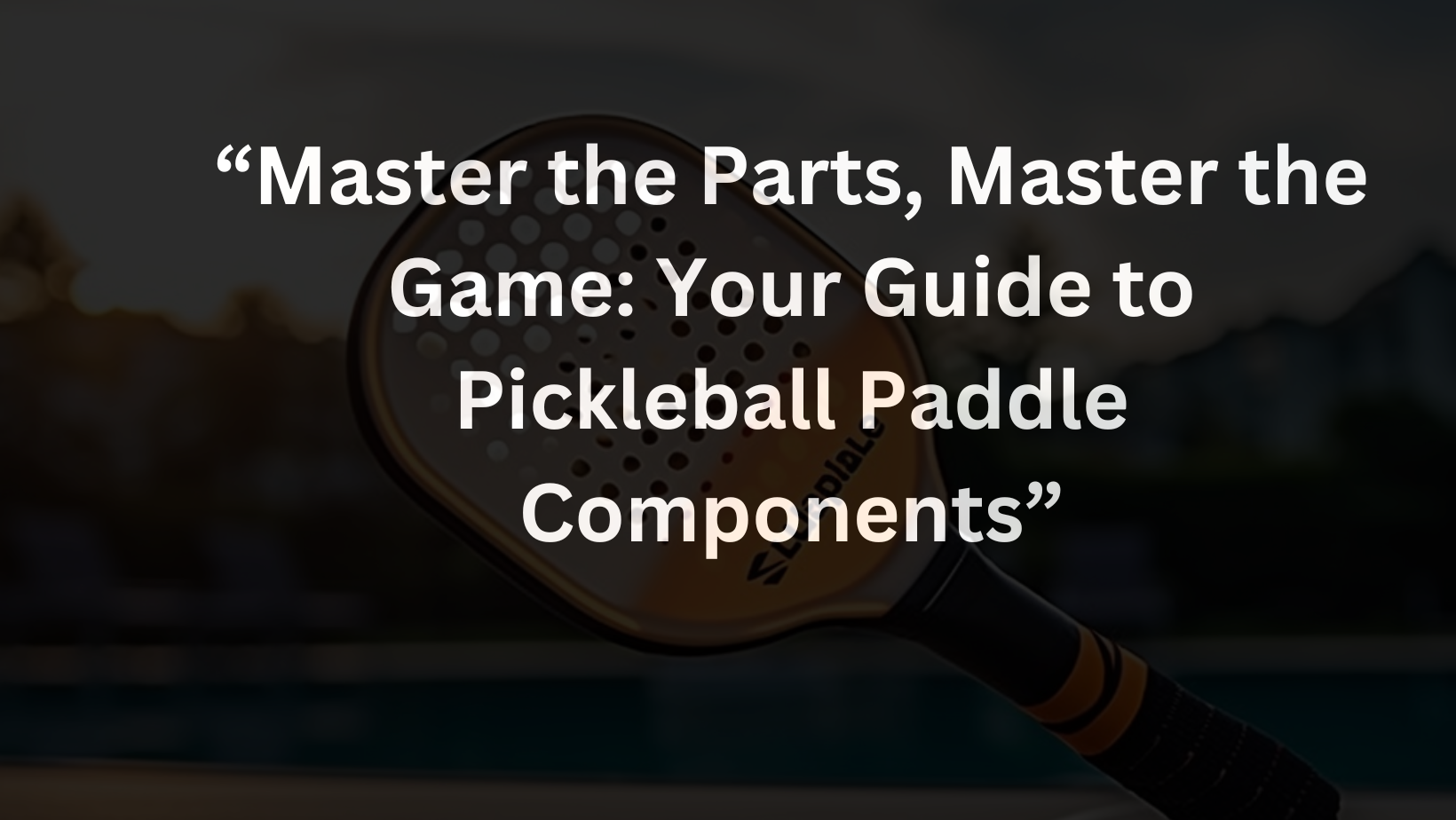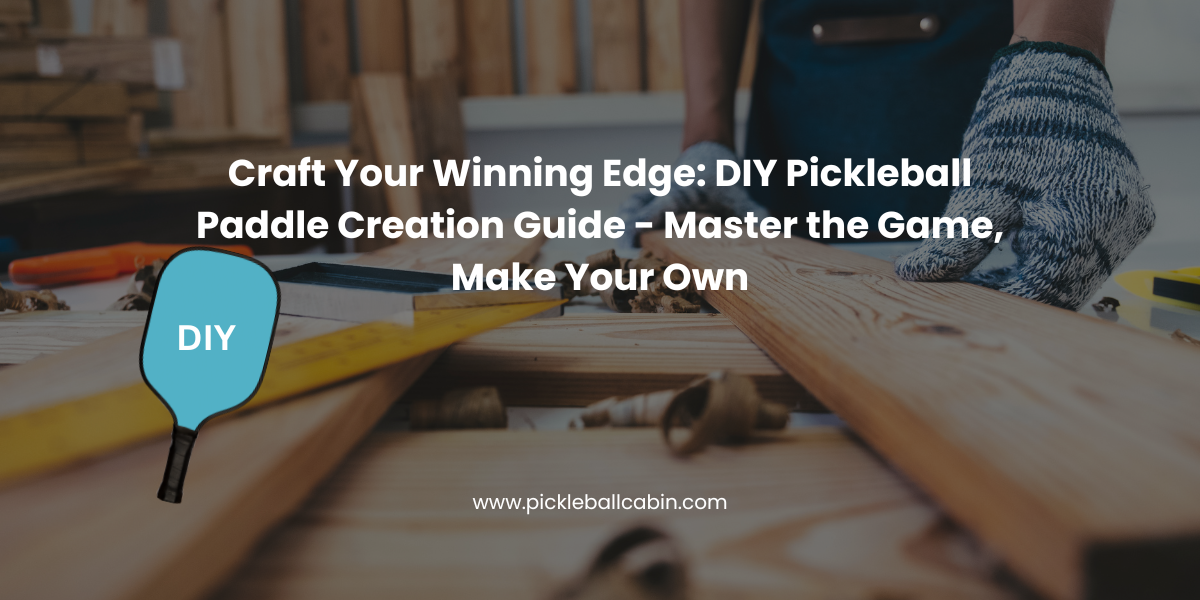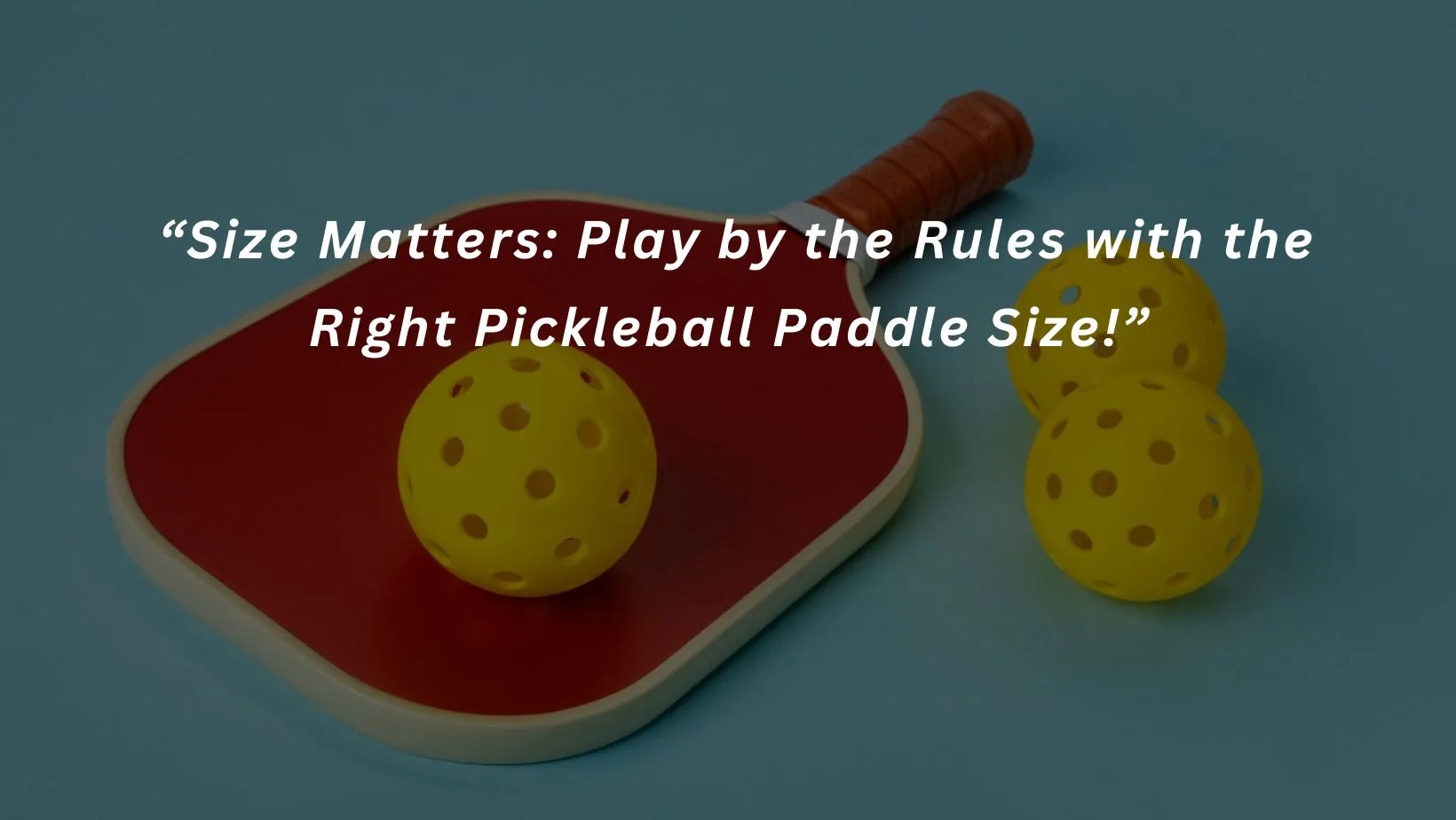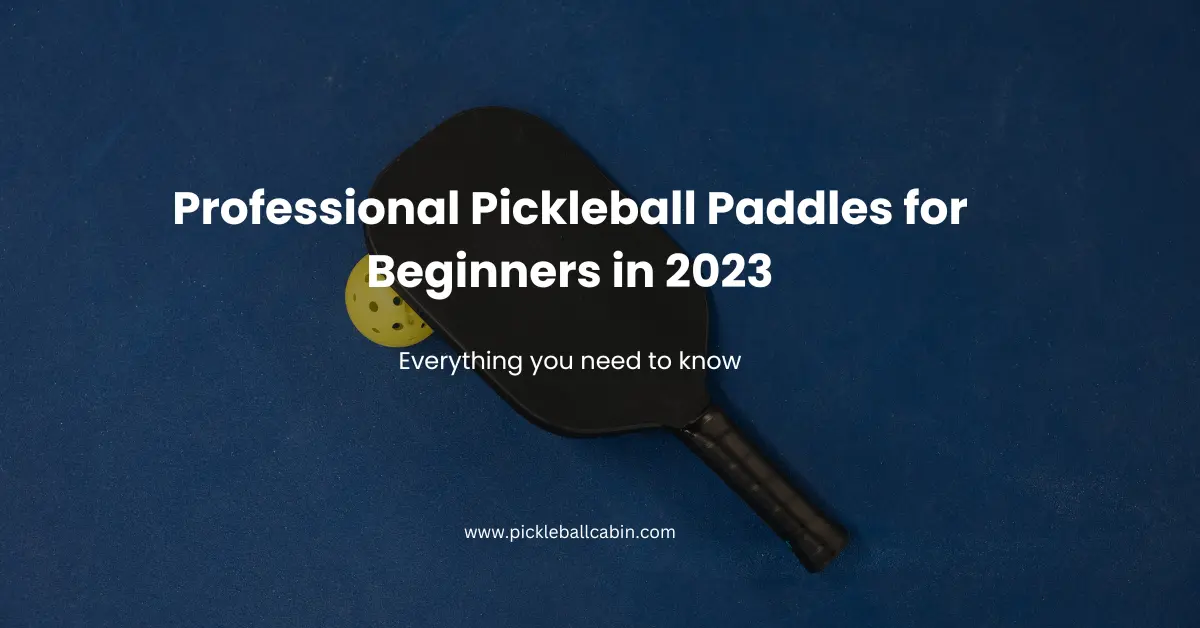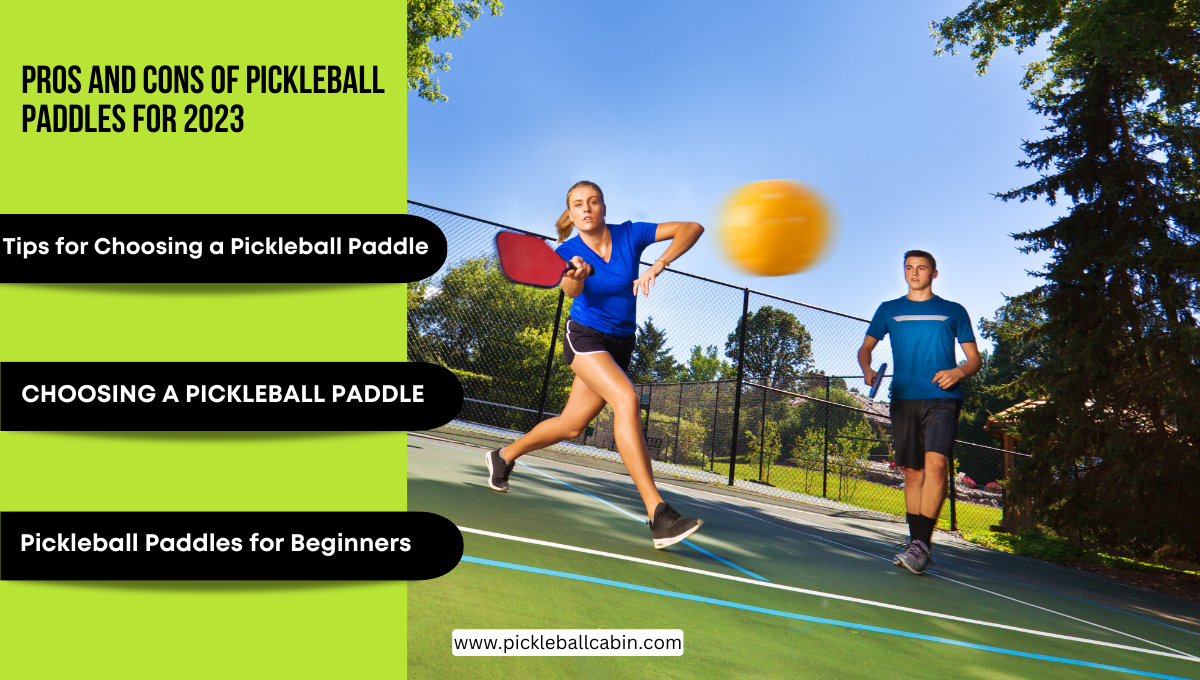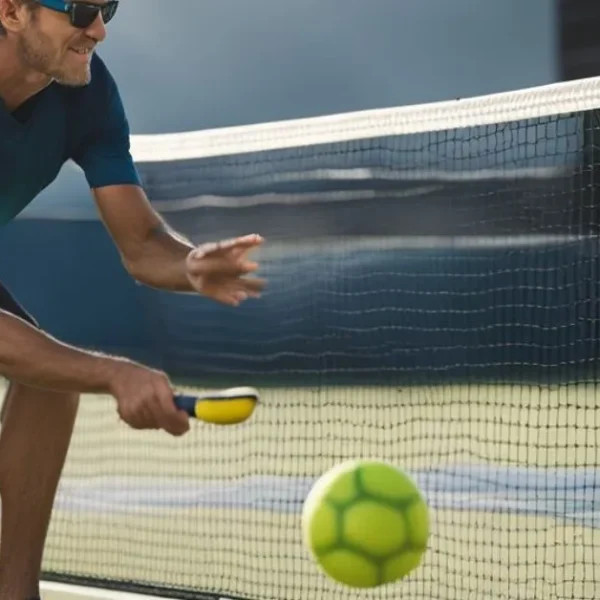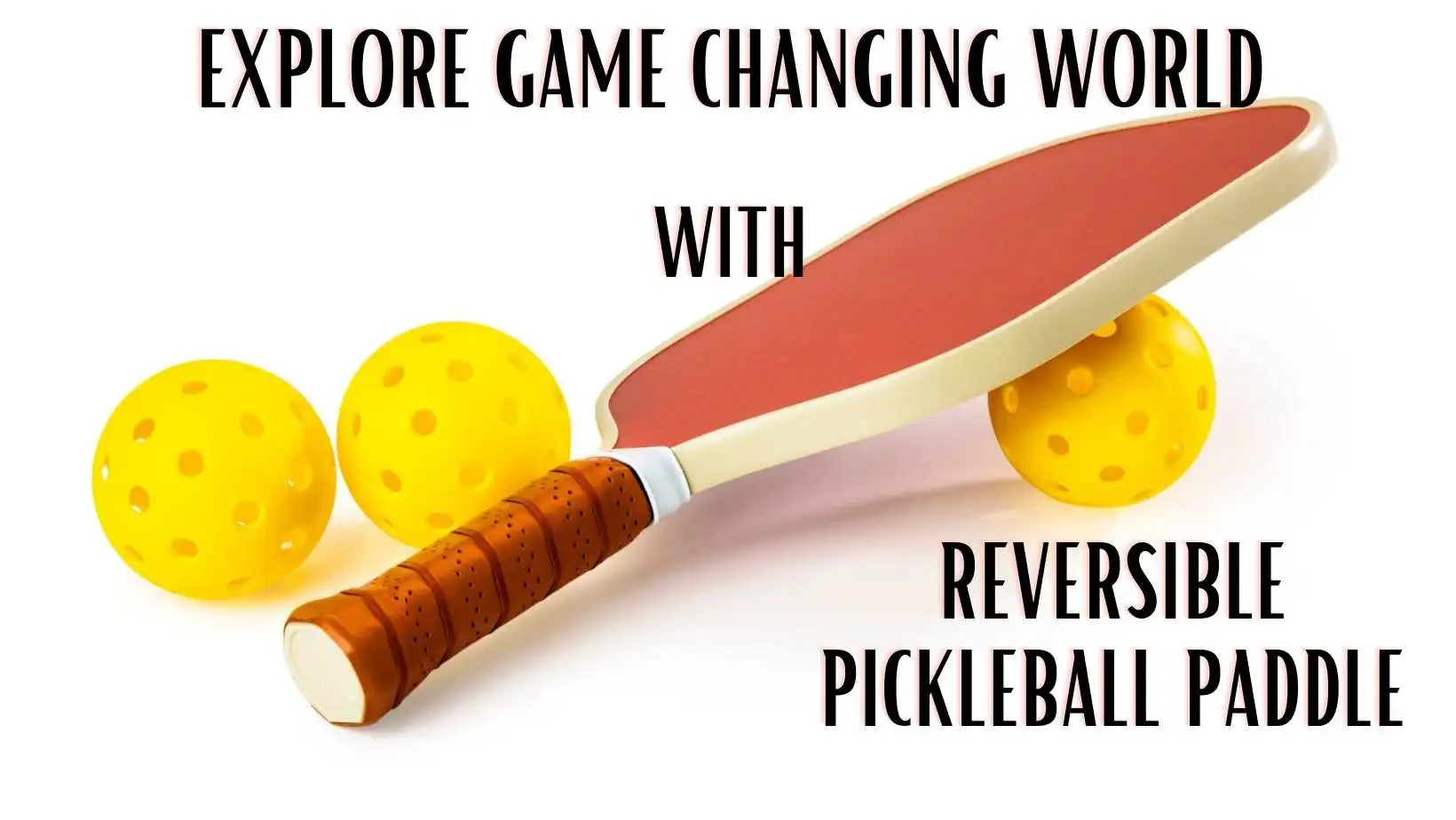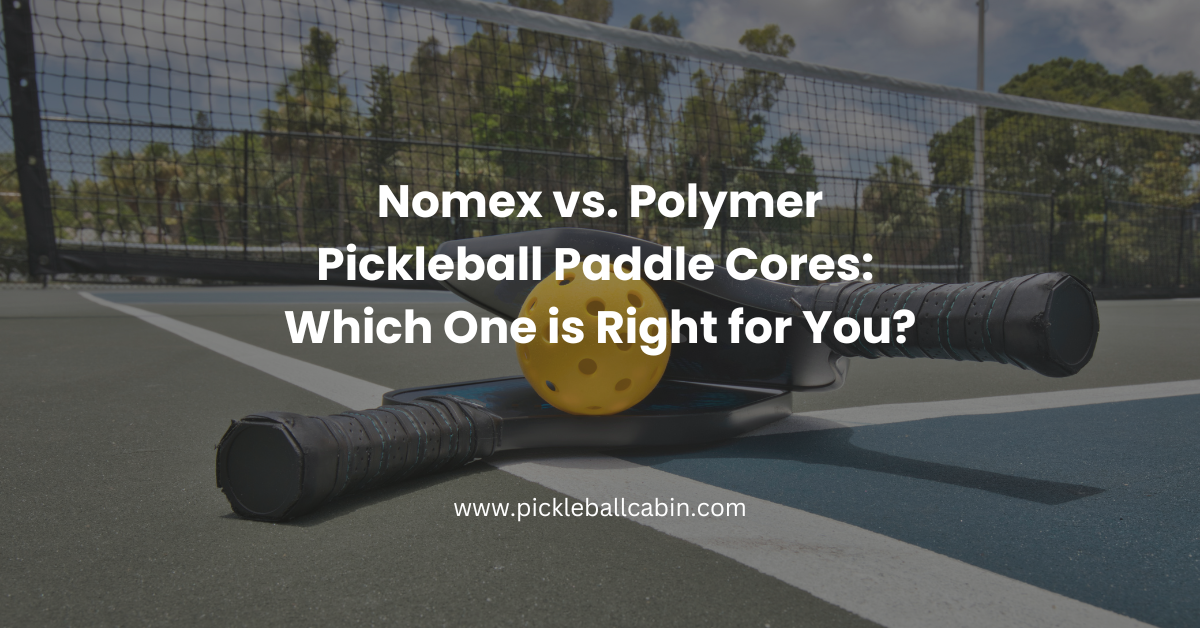Parts of a Pickleball Paddle
Pickleball paddles are the most important equipment in the game, as they affect your performance, style, and comfort. But what are the different parts of a pickleball paddle, and how do they work? In this article, we will explore the key components of a pickleball paddle, how they are made, and how to choose the right one for your game.
Introduction to Pickleball Paddles
Pickleball paddles are similar to table tennis paddles, but they are larger and more rigid. They are usually made of composite materials, such as wood, polymer, aluminum, carbon fiber, or fiberglass. The body of a pickleball paddle has two sections: the core and the face. The core is the inner layer that provides the structure and strength of the paddle. The face is the outer layer that covers the core on both sides of the paddle to help prevent damage while adding particular attributes. The core and the face can be made of different materials, depending on the desired characteristics of the paddle.
The handle is the part of the paddle that you hold onto. It is usually made of wood, composite, or carbon fiber. The grip is the part of the handle that you actually hold onto. It is usually made of rubber or synthetic materials. The grip is important because it helps you keep the paddle in your hand and provides a comfortable feel for your strokes. The butt cap is the end of the paddle where the handle meets the paddle face. The butt cap helps to protect the paddle from wear and tear.
The edge guard is a strip of material that runs along the paddle face and wraps around the edges. The edge guard helps to protect the paddle from wear and tear, especially when hitting the ground or the net. Some paddles have an edgeless design, which means they do not have an edge guard. This can reduce the weight and increase the hitting surface of the paddle, but it also makes the paddle more vulnerable to damage.
Key Elements of a Pickleball Paddle
There are many factors that affect the performance and feel of a pickleball paddle. Some of the most important ones are the shape, weight, core, and face material of the paddle. Let’s take a closer look at each of these elements and how they influence your game.
Shape of Pickleball Paddles
The shape of the paddle determines the size and distribution of the hitting surface, also known as the sweet spot. The sweet spot is the area on the paddle face that produces the best results when hitting the ball. It is usually located in the center of the paddle face, but it can vary depending on the shape and design of the paddle. There are three main types of paddle shapes: classic, oversized, and elongated.
- Classic Shape: This is the most common and traditional shape of a pickleball paddle. It has a rectangular shape with rounded corners and a standard width of 8 inches. The classic shape offers a balanced and consistent sweet spot, suitable for all levels of players and styles of play. It is also the most versatile and adaptable shape, as it can handle any type of shot and situation.
- Oversized Faces: These are paddles that have a wider face than the classic shape, usually between 8.5 and 9 inches. The oversized shape provides a larger sweet spot and more hitting surface, which can improve your accuracy and consistency. It can also help you generate more power and spin, as you have more contact area with the ball. However, the oversized shape can also make the paddle heavier and less maneuverable, which can affect your control and speed.
- Elongated Paddles: These are paddles that have a longer face than the classic shape, usually between 16 and 17 inches. The elongated shape provides a longer reach and more leverage, which can help you cover more court and hit harder shots. It can also help you with overhead and volley shots, as you have more room to swing and hit the ball. However, the elongated shape can also reduce the sweet spot and the hitting surface, which can affect your accuracy and consistency. It can also make the paddle more difficult to control and balance, especially for beginners.
Handle of Pickleball Paddles
The handle is the part of the paddle that you hold onto. It affects your comfort, grip, and stroke technique. There are two main aspects of the handle that you need to consider: the length and the size.
- Understanding Paddle Handles: The length of the handle is the distance from the butt cap to the paddle face. The length of the handle can vary from 4 to 6 inches, depending on the brand and model of the paddle. The length of the handle affects the balance and maneuverability of the paddle. A longer handle can provide more stability and leverage, which can help you with power and spin. A shorter handle can provide more agility and responsiveness, which can help you with control and finesse. The length of the handle also affects the size of the paddle face. A longer handle means a smaller paddle face, and vice versa. A smaller paddle face can provide more precision and consistency, while a larger paddle face can provide more forgiveness and power.
- Measuring Grip Size for a Pickleball Paddle: The size of the grip is the circumference of the handle. The size of the grip can vary from 4 to 4.5 inches, depending on the brand and model of the paddle. The size of the grip affects your comfort, grip, and stroke technique. A larger grip size can provide more stability and support, which can help you with power and accuracy. A smaller grip size can provide more flexibility and movement, which can help you with control and spin. The size of the grip also affects the weight distribution of the paddle. A larger grip size means more weight in the handle, and vice versa. More weight in the handle can provide more balance and stability, while more weight in the head can provide more momentum and power.
The best way to measure your grip size is to use measuring tape or a ruler. Wrap the tape or the ruler around the thickest part of your palm, just below your fingers. The number that you get is your grip size. You can also use the following method to estimate your grip size. Hold the paddle in your dominant hand, as if you are ready to hit the ball. There should be a small gap between your fingers and your palm, about the width of your index finger. If the gap is too large or too small, you need to adjust your grip size accordingly.
Weight of Pickleball Paddles
The weight of the paddle is one of the most important factors that affect your performance and feel. The weight of the paddle affects the power and control of your strokes, as well as your comfort and fatigue. Most paddles weigh between 6 and 10 ounces, but there are some exceptions. The weight of the paddle is determined by the materials and the design of the paddle, especially the core and the face.
- How Weight Affects Your Game: The weight of the paddle can have a significant impact on your game, depending on your skill level, playing style, and personal preference. In general, heavier paddles provide more power, while lighter paddles provide more control.
Heavier paddles can help you generate more force and speed, as they have more mass and momentum. They can also help you with defensive shots, such as blocking and lobbing, as they can absorb more impact and vibration. However, heavier paddles can also make you more prone to fatigue and injury, as they require more strength and effort to swing. They can also affect your accuracy and consistency, as they can be harder to maneuver and adjust.
Lighter paddles can help you generate more spin and finesse, as they have less mass and inertia. They can also help you with offensive shots, such as drop shots and dinks, as they can offer more touch and feel. However, lighter paddles can also make you more vulnerable to power and wind, as they have less stability and resistance. They can also affect your power and distance, as they can be harder to hit through the ball.
- Choosing the Right Weight: The best way to choose the right weight for your paddle is to try different paddles and see how they feel and perform. You can also use the following guidelines to help you narrow down your options. If you are a beginner or an intermediate player, you may want to start with a mid-weight paddle, between 7 and 8 ounces. This can provide you with a good balance of power and control, as well as comfort and durability. If you are an advanced or a professional player, you may want to experiment with different weights, depending on your playing style and preference. If you are a power player, you may want to go for a heavier paddle, between 8 and 9 ounces. This can provide you with more force and speed, as well as more stability and defense. If you are a finesse player, you may want to go for a lighter paddle, between 6 and 7 ounces. This can provide you with more spin and touch, as well as more agility and offense.
- Popular Weight Ranges: There are some popular weight ranges that are preferred by many players, depending on their skill level and playing style. Here are some of them:
- 6 to 7 ounces: This is the lightest weight range, suitable for players who value control, spin, and finesse. It is also ideal for players who have arm or shoulder problems, as it can reduce the stress and fatigue on the joints and muscles. However, this weight range can also compromise the power and stability of the paddle, as well as the durability and resistance to damage.
- 7 to 8 ounces: This is the most popular and versatile weight range, suitable for players of all skill levels and styles. It can provide a good balance of power and control, as well as comfort and durability. It can also adapt to different types of shots and situations, making it a reliable and consistent choice.
- 8 to 9 ounces: This is the heaviest weight range, suitable for players who value power, speed, and defense. It can provide more force and momentum, as well as more stability and resistance. It can also help with blocking and lobbing shots, as well as hitting through the wind. However, this weight range can also increase the stress and fatigue on the joints and muscles, as well as the difficulty and risk of injury.
Paddle Cores
The core is the inner layer of the paddle that provides the structure and strength of the paddle. The core affects the weight, stiffness, and sound of the paddle, as well as the power and control of your strokes. The core can be made of different materials, each with its own advantages and disadvantages. The most common core materials are polymer, aluminum, nomex, and wood.
- Importance of Paddle Cores: The core is the most important part of the paddle, as it determines the performance and feel of the paddle. The core affects the following aspects of the paddle:
- Weight: The core is the heaviest part of the paddle, as it makes up the bulk of the paddle. The weight of the core affects the overall weight of the paddle, as well as the weight distribution and balance of the paddle. A heavier core means a heavier paddle, and vice versa. A heavier core also means more weight in the head of the paddle, and vice versa.
- Stiffness: The core is the stiffest part of the paddle, as it provides the rigidity and durability of the paddle. The stiffness of the core affects the flex and vibration of the paddle, as well as the power and control of your strokes. A stiffer core means a more rigid and durable paddle, and vice versa. A stiffer core also means more power and less control, and vice versa.
- Sound: The core is the loudest part of the paddle, as it produces the sound when hitting the ball. The sound of the core affects the noise and feedback of the paddle, as well as the preference and enjoyment of the players. A louder core means a more noisy and noticeable paddle, and vice versa. A louder core also means more feedback and feel, and vice versa.
- Different Core Materials: The core can be made of different materials, each with its own characteristics and benefits. The most common core materials are:
- Polymer Core: This is the most popular and modern core material, made of a plastic blend with a honeycomb structure. The polymer core is the lightest and softest core material, providing a quiet and comfortable paddle. The polymer core also provides a good balance of power and control, as well as a large and consistent sweet spot. The polymer core is ideal for players who want a lightweight and versatile paddle, as well as a smooth and forgiving paddle.
- Aluminum Core: This is the second most popular core material, made of aluminum with a honeycomb structure. The aluminum core is the heaviest and stiffest core material, providing a loud and powerful paddle. The aluminum core also provides more stability and resistance, as well as more force and speed. The aluminum core is ideal for players who want a heavy and durable paddle, as well as a strong and defensive paddle.
- Nomex Core: This is the oldest and original core material, made of a synthetic material with a honeycomb structure. The nomex core is the lightest and stiffest core material, providing a loud and rigid paddle. The nomex core also provides more power and less control, as well as a smaller and inconsistent sweet spot. The nomex core is ideal for players who want a lightweight and aggressive paddle, as well as a fast and hard-hitting paddle.
- Wood Core: This is the simplest and cheapest core material, made of solid wood or plywood. The wood core is the heaviest and softest core material, providing a quiet and basic paddle. The wood core also provides less power and more control, as well as a large and forgiving sweet spot. The wood core is ideal for players who want a cheap and beginner-friendly paddle, as well as a simple and easy-to-use paddle.
- Which Core Material Suits Your Style?
The best way to choose the right core material for your paddle is to try different paddles and see how they feel and perform. You can also use the following guidelines to help you narrow down your options.
If you are a beginner or an intermediate player, you may want to start with a polymer core, as it can provide you with a good balance of power and control, as well as a quiet and comfortable paddle.
If you are an advanced or a professional player, you may want to experiment with different core materials, depending on your playing style and preference.
If you are a power player, you may want to go for an aluminum or a nomex core, as they can provide you with more force and speed, as well as more stability and resistance.
If you are a finesse player, you may want to go for a polymer or a wood core, as they can provide you with more spin and touch, as well as more forgiveness and feel.
Read More at; Nomex Vs. Polymer Pickleball Paddle Cores: Which One Is Right For You?
Edge Guard on Pickleball Paddles
The edge guard is a strip of material that runs along the paddle face and wraps around the edges. The edge guard helps to protect the paddle from wear and tear, especially when hitting the ground or the net. Some paddles have an edgeless design, which means they do not have an edge guard. This can reduce the weight and increase the hitting surface of the paddle, but it also makes the paddle more vulnerable to damage.
- Purpose of Edge Guards: The edge guard serves two main purposes: to protect the paddle and to enhance the performance. The edge guard protects the paddle from damage, such as chips, cracks, and dents, that can occur when hitting the ground or the net. The edge guard also enhances the performance of the paddle, by providing more stability and balance, as well as more power and control. The edge guard adds some weight and stiffness to the paddle, which can help you generate more force and speed, as well as more accuracy and consistency.
Grip on Pickleball Paddles
The grip is the part of the handle that you actually hold onto. It affects your comfort, grip, and stroke technique. There are two main types of grips: the overgrip and the replacement grip. The overgrip is a thin layer of material that wraps around the original grip. The overgrip can help you customize the size, feel, and look of your grip, as well as provide some cushioning and absorption. The replacement grip is a thicker layer of material that replaces the original grip. The replacement grip can help you change the size, feel, and look of your grip, as well as provide more cushioning and absorption.
- Finding the Ideal Grip: The best way to find the ideal grip for your paddle is to try different grips and see how they feel and perform. You can also use the following guidelines to help you narrow down your options. If you want a larger grip size, you can use an overgrip or a replacement grip to increase the circumference of your handle. If you want a smaller grip size, you can use a replacement grip to decrease the circumference of your handle. If you want a softer grip, you can use an overgrip or a replacement grip to add some cushioning and absorption to your handle. If you want a harder grip, you can use a replacement grip to remove some cushioning and absorption from your handle. If you want a smoother grip, you can use an overgrip or a replacement grip to reduce the friction and texture of your handle. If you want a rougher grip, you can use a replacement grip to increase the friction and texture of your handle.
Remember, your paddle grip is the connection between you and the paddle, so it’s important to choose a grip that feels comfortable and secure in your hand.
How to Put Overgrip on Pickleball Paddle?
9 Main Parts of a Pickleball Paddle
Sure, here’s a table that provides a brief overview of the parts of a pickleball paddle and their Importance:
| Part | Description | Importance |
|---|---|---|
| Handle | Held during play | Provides control and maneuverability |
| Grip | Material for holding | Ensures a firm hold and prevents slipping |
| Butt Cap | Handle’s end part | Adds balance and prevents the paddle from slipping |
| Paddle Face | Hits the ball | Determines the power and spin of shots |
| Sweet Spot | Best hitting area | Maximizes power and accuracy when hit |
| Edge Guard | Protects paddle edges | Prevents damage to the paddle during play |
| Core | Provides power/control | Influences the overall feel and performance of the paddle |
| Weight | Affects power/control | Heavier paddles provide more power, lighter ones offer better control |
| Size | Affects reach/power | Larger paddles provide more reach and power, but may be less maneuverable |
Each part plays a crucial role in your performance in the game. Understanding these components can help you choose the right paddle for your playing style.
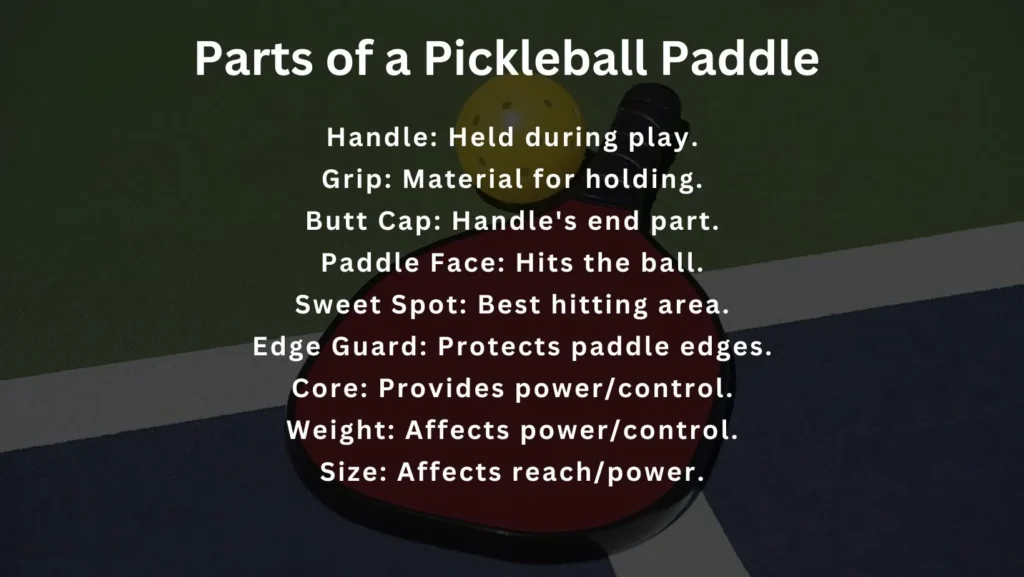
Pickleball Paddle Parts and Selection
The face material is the outer layer of the paddle that covers the core on both sides of the paddle. The face material affects the weight, stiffness, and sound of the paddle, as well as the power and control of your strokes. The face material can be made of different materials, each with its own advantages and disadvantages. The most common face materials are graphite, carbon fiber, fiberglass, hybrid, and wood.
Face Material of Pickleball Paddles
The face material is the outer layer of the paddle that covers the core on both sides of the paddle. The face material affects the weight, stiffness, and sound of the paddle, as well as the power and control of your strokes. The face material can be made of different materials, each with its own characteristics and benefits. The most common face materials are:
- Graphite Surface Paddles: This is the most popular and high-end face material, made of a thin layer of carbon graphite. The graphite surface is the lightest and stiffest face material, providing a quiet and rigid paddle. The graphite surface also provides more power and less control, as well as a smaller and consistent sweet spot. The graphite surface is ideal for players who want a lightweight and premium paddle, as well as a fast and hard-hitting paddle.
- How Does a Graphite Paddle Play? A graphite paddle plays like a rocket, as it can generate a lot of speed and force with minimal effort. A graphite paddle can help you with power and distance, as well as with defensive shots, such as blocking and lobbing. However, a graphite paddle can also make you sacrifice some control and spin, as well as some touch and feel. A graphite paddle can also be more expensive and less durable than other face materials.
- Carbon Fiber Paddles: This is a newer and more advanced face material, made of a thin layer of carbon fiber. The carbon fiber surface is similar to the graphite surface, but it has some advantages and disadvantages. The carbon fiber surface is slightly heavier and softer than the graphite surface, providing a quieter and more comfortable paddle. The carbon fiber surface also provides more control and spin, as well as a larger and more forgiving sweet spot. The carbon fiber surface is ideal for players who want a lightweight and high-quality paddle, as well as a smooth and versatile paddle.
- How Does a Carbon Fiber Paddle Play? A carbon fiber paddle plays like a dream, as it can offer a great combination of power and control. A carbon fiber paddle can help you with accuracy and consistency, as well as with offensive shots, such as drop shots and dinks. However, a carbon fiber paddle can also make you pay more and compromise some durability, as it is more expensive and less resistant than other face materials.
- Fiberglass Paddles: This is the most common and affordable face material, made of a thin layer of fiberglass. The fiberglass surface is the heaviest and softest face material, providing a loud and flexible paddle. The fiberglass surface also provides less power and more control, as well as a larger and more inconsistent sweet spot. The fiberglass surface is ideal for players who want a cheap and beginner-friendly paddle, as well as a simple and easy-to-use paddle.
- How Does a Fiberglass Paddle Play? A fiberglass paddle plays like a toy, as it can offer a lot of fun and variety. A fiberglass paddle can help you with spin and finesse, as well as with creative shots, such as slices and curves. However, a fiberglass paddle can also make you lose some power and speed, as well as some precision and stability. A fiberglass paddle can also be more prone to damage and wear, as it is less durable and resistant than other face materials.
- Hybrid Paddles: These are paddles that have a combination of different face materials, such as graphite and fiberglass, or carbon fiber and fiberglass. The hybrid surface is a compromise between the different face materials, providing a mixed and balanced paddle. The hybrid surface can provide some of the benefits and drawbacks of each face material, depending on the ratio and distribution of the materials. The hybrid surface is ideal for players who want a versatile and adaptable paddle, as well as a unique and customized paddle.
- How Does a Hybrid Paddle Play? A hybrid paddle plays like a chameleon, as it can change and adjust to different types of shots and situations. A hybrid paddle can help you with power and control, as well as with spin and touch, depending on the combination and proportion of the face materials. However, a hybrid paddle can also make you compromise some of the advantages and disadvantages of each face material, as well as some of the consistency and reliability of the paddle. A hybrid paddle can also be more expensive and complex, as it requires more materials and design.
- Wooden Paddles: These are the simplest and cheapest face material, made of solid wood or plywood. The wooden surface is the heaviest and softest face material, providing a quiet and basic paddle. The wooden surface also provides less power and more control, as well as a large and forgiving sweet spot. The wooden surface is ideal for players who want a cheap and beginner-friendly paddle, as well as a simple and easy-to-use paddle.
- How Does a Wooden Paddle Play? A wooden paddle plays like a classic, as it can offer a lot of nostalgia and simplicity. A wooden paddle can help you with control and consistency, as well as with touch and feel. However, a wooden paddle can also make you lose some power and speed, as well as some durability and resistance. A wooden paddle can also be more boring and outdated, as it lacks some of the features and benefits of other face materials.
Choosing the Right Paddle
The best way to choose the right paddle for your game is to try different paddles and see how they feel and perform. You can also use the following factors to help you narrow down your options:
- Shape: The shape of the paddle determines the size and distribution of the hitting surface, also known as the sweet spot. The shape of the paddle affects your accuracy and consistency, as well as your power and spin. You can choose from three main types of paddle shapes: classic, oversized, and elongated. The classic shape offers a balanced and consistent sweet spot, suitable for all levels of players and styles of play. The oversized shape provides a larger sweet spot and more hitting surface, which can improve your accuracy and consistency. The elongated shape provides a longer reach and more leverage, which can help you cover more court and hit harder shots.
- Weight: The weight of the paddle affects the power and control of your strokes, as well as your comfort and fatigue. The weight of the paddle is determined by the materials and the design of the paddle, especially the core and the face. You can choose from different weight ranges, depending on your skill level, playing style, and personal preference. The lightest weight range is between 6 and 7 ounces, suitable for players who value control, spin, and finesse. The most popular and versatile weight range is between 7 and 8 ounces, suitable for players of all skill levels and styles. The heaviest weight range is between 8 and 9 ounces, suitable for players who value power, speed, and defense.
- Face Material: The face material affects the weight, stiffness, and sound of the paddle, as well as the power and control of your strokes. The face material can be made of different materials, each with its own characteristics and benefits. You can choose from different face materials, depending on your skill level, playing style, and personal preference. The most popular and high-end face material is graphite, suitable for players who want a lightweight and premium paddle, as well as a fast and hard-hitting paddle. The newer and more advanced face material is carbon fiber, suitable for players who want a lightweight and high-quality paddle, as well as a smooth and versatile paddle. The most common and affordable face material is fiberglass, suitable for players who want a cheap and beginner-friendly paddle, as well as a simple and easy-to-use paddle. The simplest and cheapest face material is wood, suitable for players who want a cheap and beginner-friendly paddle, as well as a simple and easy-to-use paddle.
- Core Material: The core material affects the weight, stiffness, and sound of the paddle, as well as the power and control of your strokes. The core material can be made of different materials, each with its own characteristics and benefits. You can choose from different core materials, depending on your skill level, playing style, and personal preference. The most popular and modern core material is polymer, suitable for players who want a lightweight and versatile paddle, as well as a smooth and forgiving paddle. The second most popular core material is aluminum, suitable for players who want a heavy and durable paddle, as well as a strong and defensive paddle. The oldest and original core material is nomex, suitable for players who want a lightweight and aggressive paddle, as well as a fast and hard-hitting paddle. The simplest and cheapest core material is wood, suitable for players who want a cheap and beginner-friendly paddle, as well as a simple and easy-to-use paddle.
Which Paddle Suits Your Playing Style?
The best way to choose the right paddle for your playing style is to try different paddles and see how they suit your game. You can also use the following guidelines to help you narrow down your options. If you are a power player, you may want to go for a heavier, stiffer, and louder paddle, such as an aluminum or a nomex core with a graphite or a carbon fiber face. This can provide you with more force and speed, as well as more stability and resistance. If you are a finesse player, you may want to go for a lighter, softer, and quieter paddle, such as a polymer or a wood core with a fiberglass or a wood face. This can provide you with more spin and touch, as well as more forgiveness and feel.
Cleaning and Maintenance
- How to Clean Your Pickleball Paddle: Cleaning your pickleball paddle is important to keep it in good condition and to prevent dirt and dust from affecting your performance. The best way to clean your pickleball paddle is to use a damp cloth or a sponge and some mild soap or detergent. Gently wipe the paddle face and the handle, making sure to remove any stains or marks. Avoid using abrasive or harsh cleaners, as they can damage the paddle surface and the grip. Rinse the paddle with clean water and dry it with a soft towel or a paper towel. Store the paddle in a cool and dry place, away from direct sunlight and heat.
Care and Maintenance of pickleball Paddles
Recommendations for Beginners
- Finding a Good Pickleball Paddle for Beginners: Finding a good pickleball paddle for beginners can be challenging, as there are many options and factors to consider. The best way to find a good pickleball paddle for beginners is to try different paddles and see how they feel and perform.
You can also use the following guidelines to help you narrow down your options. If you are a beginner, you may want to start with a mid-weight paddle, between 7 and 8 ounces. This can provide you with a good balance of power and control, as well as comfort and durability. You may also want to start with a polymer core, as it can provide you with a smooth and forgiving paddle. You may also want to start with a fiberglass face, as it can provide you with a simple and easy-to-use paddle. You may also want to start with a classic shape, as it can provide you with a balanced and consistent sweet spot.
Comparing Materials
- Graphite vs. Fiberglass for Pickleball Paddles: Graphite and fiberglass are two of the most common and popular face materials for pickleball paddles. They have some similarities and differences, depending on your skill level, playing style, and personal preference. Here are some of the main points of comparison between graphite and fiberglass:
- Weight: Graphite is lighter than fiberglass, which can make the paddle more agile and responsive. Fiberglass is heavier than graphite, which can make the paddle more stable and resistant.
- Stiffness: Graphite is stiffer than fiberglass, which can make the paddle more rigid and durable. Fiberglass is softer than graphite, which can make the paddle more flexible and comfortable.
- Sound: Graphite is quieter than fiberglass, which can make the paddle more discreet and pleasant. Fiberglass is louder than graphite, which can make the paddle more noticeable and feedback.
- Power: Graphite provides more power than fiberglass, which can make the paddlefaster and more hard-hittingg. Fiberglass provides less power than graphite, which can make the paddle slower and soft-hitting.
- Control: Graphite provides less control than fiberglass, which can make the paddle more difficult and riskier. Fiberglass provides more control than graphite, which can make the paddle easier and safer.
- Spin: Graphite provides less spin than fiberglass, which can make the paddle more straightforward and consistent. Fiberglass provides more spin than graphite, which can make the paddle more creative and varied.
- Price: Graphite is more expensive than fiberglass, which can make the paddle more premium and high-end. Fiberglass is cheaper than graphite, which can make the paddle more affordable and low-end.
- Understanding the Advantages of Different Core Materials: The core material is the most important part of the paddle, as it determines the performance and feel of the paddle. The core material can be made of different materials, each with its own advantages and disadvantages. Here are some of the main advantages of each core material:
- Polymer Cores: Polymer cores are the most popular and modern core material, made of a plastic blend with a honeycomb structure. The main advantages of polymer cores are:
- They are the lightest and softest core material, providing a quiet and comfortable paddle.
- They provide a good balance of power and control, as well as a large and consistent sweet spot.
- They are ideal for players who want a lightweight and versatile paddle, as well as a smooth and forgiving paddle.
- Nomex Cores: Nomex cores are the oldest and original core material, made of a synthetic material with a honeycomb structure. The main advantages of nomex cores are:
- They are the lightest and stiffest core material, providing a loud and rigid paddle.
- They provide more power and less control, as well as a smaller and inconsistent sweet spot.
- They are ideal for players who want a lightweight and aggressive paddle, as well as a fast and hard-hitting paddle.
- Aluminum Cores: Aluminum cores are the second most popular core material, made of aluminum with a honeycomb structure. The main advantages of aluminum cores are:
- They are the heaviest and stiffest core material, providing a loud and powerful paddle.
- They provide more stability and resistance, as well as more force and speed.
- They are ideal for players who want a heavy and durable paddle, as well as a strong and defensive paddle.
- Polymer Cores: Polymer cores are the most popular and modern core material, made of a plastic blend with a honeycomb structure. The main advantages of polymer cores are:
Summary of Material Choices
The best way to choose the right material for your paddle is to try different paddles and see how they feel and perform. You can also use the following summary to help you narrow down your options. The best material for your paddle depends on your skill level, playing style, and personal preference.
- If You Want Power: If you want a paddle that can help you generate more force and speed, as well as more stability and resistance, you may want to go for a heavier, stiffer, and louder paddle, such as an aluminum or a nomex core with a graphite or a carbon fiber face.
- If You Want Control: If you want a paddle that can help you generate more spin and finesse, as well as more forgiveness and feel, you may want to go for a lighter, softer, and quieter paddle, such as a polymer or a wood core with a fiberglass or a wood face.
- If You Want Lightweight Quality: If you want a paddle that can offer you a great combination of power and control, as well as a quiet and comfortable paddle, you may want to go for a polymer core with a graphite or a carbon fiber face.
- If You Don’t Mind a Heavier Paddle: If you want a paddle that can offer you a good balance of power and control, as well as a loud and durable paddle, you may want to go for an aluminum core with a fiberglass face.
Conclusion
Pickleball paddles are the most important equipment in the game, as they affect your performance, style, and comfort. There are many factors that affect the performance and feel of a pickleball paddle, such as the shape, weight, core, and face material of the paddle. The best way to choose the right paddle for your game is to try different paddles and see how they feel and perform. You can also use the information and guidelines in this article to help you narrow down your options. The best paddle for your game depends on your skill level, playing style, and personal preference. We hope you enjoyed this article and learned something new about pickleball paddles.
FAQ
Q: What are the different parts of a pickleball paddle?
A: The different parts of a pickleball paddle include the construction and materials, grip, paddle face, paddle core, and paddle edge guard, weight, and dimensions.
Q: What materials are used in pickleball paddle construction?
A: Pickleball paddles are commonly made using materials such as graphite, composite, and wood. Each material has its own unique characteristics that can affect the performance and feel of the paddle.
Q: Why is paddle grip important?
A: Paddle grip is important as it can significantly impact your gameplay. Different types of grips, such as cushioned grips, perforated grips, and overgrips, offer varying levels of comfort and traction. It is essential to choose a grip that suits your playing style and provides a secure hold on the paddle.
How To Determine Pickleball Paddle Grip Size: Expert Tips & Guide
Q: How does the paddle face affect gameplay?
A: The paddle face, which is the surface that comes in contact with the ball, can affect spin, control, and power in your shots. Factors such as the texture, finish, and coatings of the paddle face play a role in how the ball interacts with the paddle.
Q: What is the paddle core?
A: The paddle core refers to the inner material of the paddle. There are different types of paddle cores, including polymer cores, aluminum cores, and Nomex cores. The core material affects the paddle’s performance and can impact factors like power, control, and paddle deflection.
Q: What is the purpose of the paddle edge guard?
A: The paddle edge guard is designed to protect the paddle’s edges from damage during gameplay. It acts as a barrier against accidental hits and impacts, prolonging the lifespan of the paddle.
Protect Your Gear With Pickleball Paddle Edge Guard Tape | US Guide
Q: How does paddle weight and dimensions affect gameplay?
A: Paddle weight and dimensions, such as length, width, and grip length, can influence your playing style. Lighter paddles offer increased maneuverability, while heavier paddles provide more power. The dimensions of the paddle, particularly the grip length, can also affect your comfort and control on the court.
